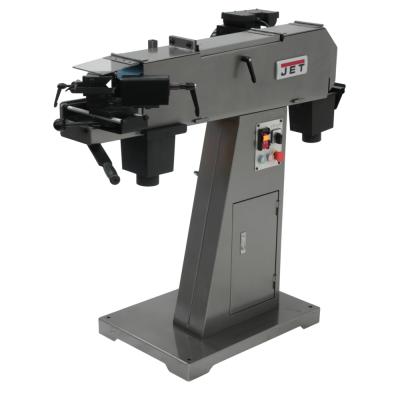
The new JET dual-station abrasive pipe notcher does extra duty to maximize shop productivity and output. Its innovative two-station design provides quick and easy access to notching, grinding and deburring at three different work stations.
The abrasive pipe notcher is made to last with heavy-gauge steel construction throughout. This multitasking machine is engineered to notch pipe from ½ to 2½ in. diameter at the front station. It is capable of notching angles from 90 to 30o by use of a multipositional hand lever vise.
Seven interchangeable rollers come standard and require no tools to install. Mandrel sizes include ½. ¾, 1, 1 ¼, 1½, 2 and 2 ½ in. Rollers are conveniently stored in an onboard compartment at the machine’s base.
A forward/reverse switch changes belt direction, allowing the operator to switch from notching to standard grinding at the rear of the machine. For grinding large workpieces, a hinged top cover opens to provide access to the entire length of the 4 in. x 79 in. belt surface. Three replacement belts of 36, 60 and 80 grit and a belt guard come standard.
A safety shield and two 3 in. dust ports help direct sparks and debris away from the operator. The dust ports mount easily to a metalworking dust collector.
The versatile abrasive notcher is powered by a totally enclosed, fan cooled, AC induction motor rated at 3 or 4 HP with a speed of 3,400 rpm. The machine is available in single or three-phase models to allow installation in different shop environments.
A safety switch on the power key helps prevent accidental start-ups. The notcher is CSA/US certified.
The JET dual-station abrasive pipe notcher-1Ph (756180) and dual-station abrasive pipe notcher-3 Ph (756185) are covered by a 2-year warranty, as well as JET’s RED Assurance.
Contact Details
Related Glossary Terms
- abrasive
abrasive
Substance used for grinding, honing, lapping, superfinishing and polishing. Examples include garnet, emery, corundum, silicon carbide, cubic boron nitride and diamond in various grit sizes.
- grinding
grinding
Machining operation in which material is removed from the workpiece by a powered abrasive wheel, stone, belt, paste, sheet, compound, slurry, etc. Takes various forms: surface grinding (creates flat and/or squared surfaces); cylindrical grinding (for external cylindrical and tapered shapes, fillets, undercuts, etc.); centerless grinding; chamfering; thread and form grinding; tool and cutter grinding; offhand grinding; lapping and polishing (grinding with extremely fine grits to create ultrasmooth surfaces); honing; and disc grinding.
- mandrel
mandrel
Workholder for turning that fits inside hollow workpieces. Types available include expanding, pin and threaded.
- metalworking
metalworking
Any manufacturing process in which metal is processed or machined such that the workpiece is given a new shape. Broadly defined, the term includes processes such as design and layout, heat-treating, material handling and inspection.
